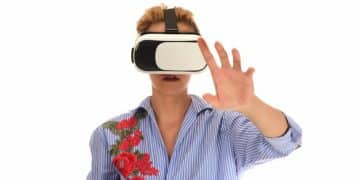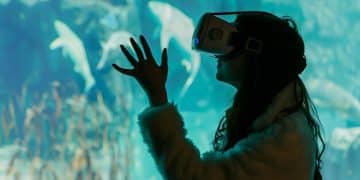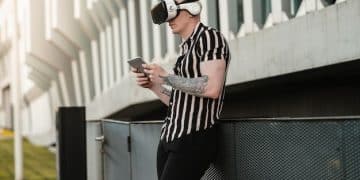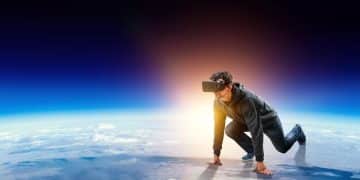The Rise of Eye Tracking in VR: Immersion and Foveated Rendering
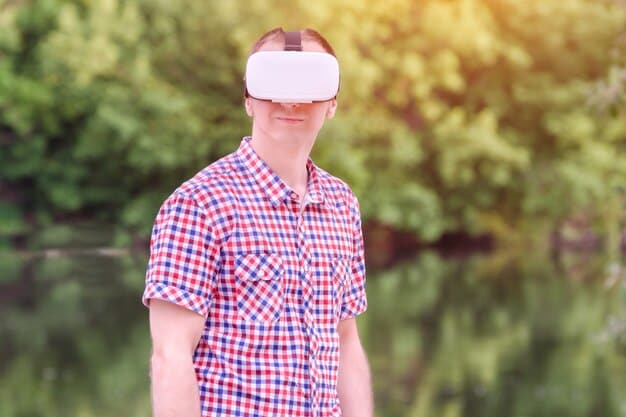
The rise of eye tracking in VR enhances immersion by allowing virtual experiences to feel more natural and responsive, and it also improves performance via foveated rendering, focusing computational power on the areas the user is directly observing.
The world of virtual reality is constantly evolving, pushing the boundaries of what’s possible in digital experiences. One of the most exciting advancements is **the rise of eye tracking in VR: enhanced immersion and foveated rendering**. This technology promises to revolutionize how we interact with virtual environments, making them more realistic, responsive, and efficient.
The Basics of Eye Tracking in VR
Eye tracking in VR is a technology that allows a VR headset to detect and track the user’s gaze. This data can then be used to create more immersive and interactive experiences. Understanding the fundamentals of how this technology works is key to appreciating its potential.
How Eye Tracking Works
VR eye tracking systems typically use infrared sensors and cameras built into the VR headset. These components work together to capture the movement and position of the user’s eyes. The data is then processed by sophisticated algorithms to determine exactly where the user is looking within the virtual environment.
Key Components
The key components of an eye-tracking VR system include:
- Infrared (IR) Emitters: These illuminate the eyes with infrared light, which is invisible to the human eye and doesn’t interfere with the VR experience.
- IR Sensors/Cameras: These cameras capture the reflection of the infrared light off the user’s eyes.
- Processing Unit: This unit runs algorithms to analyze the captured data and determine the gaze direction.
- Calibration Software: Essential for setting up the system to accurately track each user’s unique eye characteristics.
With its ability to precisely track a user’s gaze, eye tracking unlocks new levels of interaction and realism in VR, setting the stage for more personalized and engaging experiences.
Enhanced Immersion Through Eye Tracking
One of the most significant benefits of integrating eye tracking into VR is the enhanced sense of immersion it provides. By mirroring natural eye movements and behaviors, the virtual world becomes more believable and engaging.
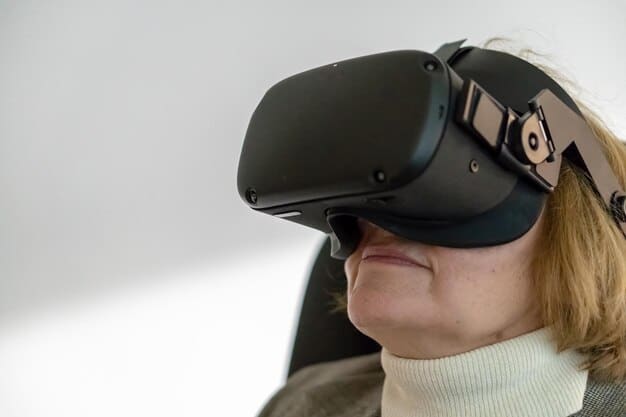
Natural Interactions
Eye tracking enables more natural interactions within VR. When you look at an object, the system knows you are interested in it. This allows for intuitive interactions such as:
- Gaze-based Selection: Simply looking at an object can trigger an action, like highlighting it or bringing up an options menu.
- Dynamic Focus: The VR environment can respond to where you are looking, bringing objects into sharper focus as your gaze shifts.
- Realistic Social Interactions: In social VR applications, eye tracking allows avatars to mimic real eye contact, making conversations feel more authentic.
These gaze-driven functionalities create a more seamless and intuitive user experience, blurring the lines between the physical and virtual worlds.
Improved Social Presence
In social VR, avatars reflecting real-time eye movements can dramatically improve feelings of connection and presence. By accurately mirroring eye contact and expressions, virtual interactions become more human-like.
Eye tracking can also enhance non-verbal communication cues, allowing users to better understand and respond to social signals, reducing misinterpretations and improving overall communication quality in virtual shared spaces.
The increased sense of presence and realism that eye tracking brings to social VR makes virtual connections feel more genuine and impactful, enhancing the overall social experience.
Foveated Rendering: Optimizing VR Performance
Foveated rendering is a cutting-edge rendering technique that leverages eye tracking to significantly improve VR performance. By intelligently allocating processing power, it enables higher resolution visuals without requiring more powerful hardware.
How Foveated Rendering Works
Foveated rendering is based on the principle that the human eye only perceives high detail in a small area at the center of our gaze (the fovea). The premise is simple:
- Render the area the user is directly looking at in high resolution and maximum detail.
- Render the peripheral areas in lower resolution, gradually decreasing detail as you move away from the center of focus.
This way, the user perceives a sharp, clear image where it matters most, while the lower resolution in the periphery is virtually unnoticeable because our eyes are less sensitive to detail there.
Benefits of Foveated Rendering
There are several notable advantages to using foveated rendering in VR:
- Increased Performance: By reducing the rendering workload in peripheral areas, the system can achieve higher frame rates and smoother performance.
- Higher Visual Fidelity: Resources saved can be reallocated to increase the resolution and visual quality in the foveated region, resulting in sharper, more detailed images.
- Reduced Hardware Requirements: Foveated rendering can make high-end VR experiences accessible on less powerful hardware, broadening the range of compatible devices.
Dynamic Foveated Rendering
The most advanced implementations of foveated rendering use dynamic adjustment based on real-time eye tracking. This means that the high-resolution area moves instantly as the user’s gaze shifts, ensuring that the focal point is always rendered in the highest possible detail.
Eye tracking enables foveated rendering techniques to be employed accurately and efficiently, resulting in greater optimization of VR performance by tailoring the rendering process to match what the user is actually viewing.
This adaptive approach ensures visual fidelity in the area of focus while maximizing system efficiency.

Applications Across Industries
The applications of eye tracking in VR span across a broad range of industries, promising revolutionary changes in various sectors.
Gaming and Entertainment
Eye tracking in VR is transforming gaming and entertainment experiences. By enabling gaze-based interactions, games become more interactive, intuitive, and realistic.
Developers can design challenges and puzzles that require players to use their gaze strategically, adding a new layer of depth to gameplay. Eye tracking also lets VR experiences adapt in real-time to the user’s interest, creating a more personalized and engaging narrative.
Moreover, foveated rendering enhances graphical fidelity and enables smoother frame rates, ensuring a visually stunning and immersive gaming experience.
Healthcare and Training
In healthcare, eye tracking helps in diagnostics and treatment. For example, it can be used to assess cognitive functions by monitoring eye movements during specific tasks.
VR training simulations are also gaining popularity in the healthcare sector. Eye tracking can provide valuable data about trainees’ areas of focus, helping instructors assess skill levels and provide personalized feedback.
Surgical simulations can incorporate eye tracking to accurately mirror real-world scenarios, enhancing the effectiveness of training procedures.
Education and Research
Eye tracking is also transforming education and academic research. In VR-based educational programs, eye tracking can identify how students engage with the material, providing valuable insights for instructional design.
Researchers leverage eye tracking to study user behavior, attention patterns, and cognitive processes in virtual environments. This data helps optimize VR experiences, making them more effective and user-friendly.
VR and eye tracking solutions provide tools for immersive educational experiences and advanced research capabilities by gathering detailed behavioral data.
Eye tracking’s capacity to provide detailed user data helps in refining both educational strategies and research methodologies and outcomes.
Challenges and Future Directions
Despite its significant potential, integrating eye tracking into VR also presents several challenges. Overcoming these obstacles is essential to unlocking the full potential of this technology.
Technical Challenges
One of the main challenges is achieving accurate and reliable eye tracking across a diverse range of users. Factors such as eye shape, lash length, and even ambient lighting can affect the performance of eye-tracking systems.
Calibration processes need to be sophisticated enough to accommodate these individual differences, ensuring that the system works effectively for everyone. Furthermore, the computational demands of real-time eye tracking and data processing can strain device resources, affecting overall VR performance.
Reducing latency and improving the robustness of eye-tracking algorithms are ongoing areas of research and development.
Privacy Concerns
As with any technology that collects personal information, privacy is a significant concern. Eye-tracking data reveals a tremendous amount about a user’s behavior, preferences, and even cognitive state.
It is essential to develop robust privacy safeguards to ensure that this data is collected, stored, and used responsibly. Transparency and user consent are paramount to maintaining trust and avoiding potential misuse of the technology.
Future Innovations
The future of eye tracking in VR is promising, with numerous potential innovations on the horizon. As technology advances, eye-tracking systems will likely become more accurate, efficient, and affordable.
Advancements in machine learning and artificial intelligence will further enhance the capabilities of eye-tracking algorithms, improving their ability to interpret and predict user behavior. Integration with other sensing technologies, such as brain-computer interfaces, can also open new possibilities for immersive and interactive VR experiences.
These technologies hold vast potential in VR applications, with eye-tracking improving continually.
| Key Point | Brief Description |
|---|---|
| 👀 Enhanced Immersion | VR feels more natural and responsive by mirroring eye movements. |
| ⚙️ Foveated Rendering | Optimizes performance by rendering only the focused area in high resolution. |
| 🎮 Game Applications | More intuitive interfaces and gameplay. |
| 🏥 Health Applications | Training and early detection of some diseases. |
FAQ
▼
Eye tracking in VR is a technology that allows a VR headset to detect and track the user’s gaze. This data is then used to create more immersive and interactive experiences by mimicking natural eye movements.
▼
Foveated rendering optimizes VR performance by rendering the area the user is directly looking at in high resolution and the peripheral areas in lower resolution, reducing the processing workload.
▼
In social VR, eye tracking allows avatars to mimic real eye contact and expressions, making conversations feel more authentic. This enhances non-verbal communication cues and improves overall interaction quality.
▼
In healthcare, eye tracking can be used for diagnostic purposes, such as assessing cognitive functions, and in VR training simulations to provide personalized feedback to trainees.
▼
The main challenges include achieving accurate and reliable eye tracking across a diverse range of users, addressing privacy concerns, and reducing the computational demands of real-time eye tracking.
Conclusion
In conclusion, the integration of eye tracking in VR represents a significant leap forward in creating engaging and efficient virtual experiences. From enhancing immersion to optimizing performance with foveated rendering, this technology is poised to revolutionize various industries. Addressing technical and privacy challenges while embracing future innovations will be critical to realizing the full potential of eye tracking in VR.
